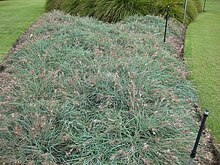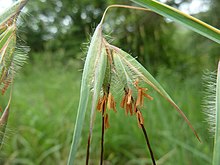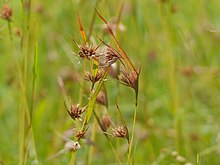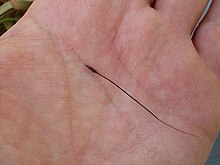fi
nimet breadcrumb-navigoinnissa


The name Themeda arguens (Linnaeus) Hackel has been misapplied to this species in Yunnan. True T. arguens is not yet known from China. It occurs from Thailand and Vietnam to Australia, and can be distinguished by its reddish culms, very large, spathate fascicles with awns 7–9 cm, and longer callus 3–4 mm. It also differs from T. triandra by its glabrous leaf sheaths, blunter leaf blades, and homogamous spikelets consisting only of the lower glume.
Rooigras (Themeda triandra) is een van die belangrikste grasspesies van Suid-Afrika. Dit is inheems en kom in alle provinsies voor, maar dit word ook wydverspreid buite die land aangetref.[1]
Dit word in soetveldstreke as 'n soetgras beskou, maar as suurgras in suurveldstreke. Hoe hoër die reënval van 'n streek hoe suurder die veld gewoonlik is. Rooigras is 'n meerjarige spesie wat dikwels 'n klimaksgras is. Dit wil sê dat dit sal oorheers in 'n volwasse gemeenskap wat vir 'n hele aantal jare gerus word ontwikkel.[2]
Dit word 30 cm tot 150 cm hoog. Die jong gras is groen of blougroen, maar dit kry pienk, rooi of pers kleure as dit ouer word. In Oktober tot Julie kry dit hangende blompakkies wat drie puntige uitsteeksels het. Die aanwesigheid van rooigras dui op 'n gesonde toestand van die veld.[3]
Rooigras is 'n belankrike deel van die oorspronklike laagrenosterveld.[4]
Rooigras (Themeda triandra) is een van die belangrikste grasspesies van Suid-Afrika. Dit is inheems en kom in alle provinsies voor, maar dit word ook wydverspreid buite die land aangetref.
Dit word in soetveldstreke as 'n soetgras beskou, maar as suurgras in suurveldstreke. Hoe hoër die reënval van 'n streek hoe suurder die veld gewoonlik is. Rooigras is 'n meerjarige spesie wat dikwels 'n klimaksgras is. Dit wil sê dat dit sal oorheers in 'n volwasse gemeenskap wat vir 'n hele aantal jare gerus word ontwikkel.
Dit word 30 cm tot 150 cm hoog. Die jong gras is groen of blougroen, maar dit kry pienk, rooi of pers kleure as dit ouer word. In Oktober tot Julie kry dit hangende blompakkies wat drie puntige uitsteeksels het. Die aanwesigheid van rooigras dui op 'n gesonde toestand van die veld.
Rooigras is 'n belankrike deel van die oorspronklike laagrenosterveld.
Themeda triandra is a species of C4 perennial tussock-forming grass widespread in Africa, Australia, Asia and the Pacific. In Australia it is commonly known as kangaroo grass[2] and in East Africa and South Africa it is known as red grass and red oat grass or as rooigras in Afrikaans. Kangaroo grass was formerly thought to be one of two species, and was named Themeda australis.
The plant has traditional uses as food and medicine in Africa and Australia. Indigenous Australians harvested it to make bread and string for fishing nets around 30,000 years ago. It was used as livestock feed in early colonial Australia, but this use was largely replaced by introduced plants. As of 2021 there is a large government-funded project under way to investigate the possibility of growing kangaroo grass commercially in Australia for use as a regular food source for humans.

Themeda triandra is a grass which grows in dense tufts up to 1.5 metres (4 ft 11 in) tall and 0.5 metres (1 ft 8 in) wide. It flowers in summer, producing large red-brown spikelets on branched stems.[3] The leaves are 10–30 centimetres (3.9–11.8 in) in length and 1–8 millimetres (0.039–0.315 in) wide[4] but can exceed 10–50 centimetres (3.9–19.7 in) long and 2–5 millimetres (0.079–0.197 in) wide.[3] Its inflorescence is compounded, fasciculated, is 10–30 centimetres (3.9–11.8 in) long and composed of a single raceme. It pedicels are oblong and are 0.5 mm long while its lemma is 25–70 millimetres (0.98–2.76 in) long and is both apical and geniculate. The column of lemma's awn is hispidulous and twisted.[4]
Its leaves are a grey-green colour in winter, turning red-brown in summer. The blooms exude a strong perfume.[5]
Themeda triandra was first formally described in 1775 by Peter Forsskål who published the description in Flora Aegyptiaco-Arabica.[6] There are many synonyms of this species.[7] The specific epithet (triandra) is the feminine of the Botanical Latin adjective triandrus, meaning "with three stamens",[8] based on the Greek-derived combining forms tri-, three, and -andrus, male.[9]
Kangaroo grass was formerly thought to be one of two species, and was named Themeda australis.[5]
Themeda triandra is found across Asia, Africa, Australia, and the Pacific. In Australia, it is found in all of the states and territories.[3] It grows predominantly in grassland and open woodland communities. It is a significant species in temperate grasslands in Australia, a habitat considered to be endangered or threatened in various parts of the country.[3] It does not do well under heavy grazing pressure, but benefits from occasional fire.[10]
It tolerates a wide range of soils but is most common in moist microclimates such as roadsides and railway lines.[11]
T. triandra occurs on a wide variety of soils from sandy soils to heavy clays. There seems to be little association between abundance of T. triandra and a specific soil type. It is often common in areas where moisture collects and grazing is light, such as along roadsides or railway lines.
Kangaroo grass is a tufted perennial up to 1.5m tall, with tussock width up to 0.5m. The narrow leaves grow up to 0.5m long, and are green in summer changing to straw coloured in winter. The seed head is large, often red-brown and made up of clustered spikelets.[12]
The young growth is palatable to livestock.[13][14] It serves as a food source for several avian species, including the long-tailed widowbird, and is occasionally used as an ornamental plant.[3]
Traditionally, in Uganda, the hollow stems of the grass are used as a thatch in hut construction, and for creating pulp for paper.[5] T. triandra seed has also been used as a famine food in Africa.[15] In West Africa, the root are used in the creation of a medicine used to treat dysmenorrhoea (painful periods).[16]
In Australia, it is sometimes used as an ornamental plant in rockeries, as a substitute for a lawn, and in cooking. It has also been found to be useful in treating horses for obesity, insulin resistance, and foot inflammation, because it is lower in carbohydrates such as sugar, starch, and fructans than introduced grasses.[5]
Before the colonisation of Australia, kangaroo grass used to be harvested by Aboriginal Australians, who used the leaves and stems for making string, the basis for fishing nets, as well as for food. The grains were harvested and ground into flour and porridge; the flour was used to make a traditional bread (later referred to as damper, although that term is mostly used for the bread made by non-Indigenous Australians), said to have a nutty flavour. Evidence has been found of this food production occurring around 30,000 years ago, with the grain considered to be a staple food and especially valuable in arid areas.[5]
However, in recent years kangaroo grass has been looked upon as a weed which is sometimes eaten by livestock. As of 2021, a four-year research project[17] supported by the Australian Government[18] is being undertaken by researcher Dylan Male, at La Trobe University in collaboration with the Dja Dja Wurrung Aboriginal Clans Corporation of central Victoria, investigating the possibility of developing it as a food crop. It is hoped that kangaroo grass would be able to be grown on a commercial scale and become a regular food source. They have found tussocks of the grass estimated to be over 50 years old, an possibly unique among Australian grasses. The plant has several advantages over currently farmed grains:[17]
However, at present the commercial viability of kangaroo grass is limited by low seed yields and poor knowledge of broadacre crop management.[19]
The project will draw heavily on the knowledge of the traditional owners of the land, and there will be ongoing communication with farmers and Landcare Australia groups.[18]
The project follows a smaller, crowdfunded project undertaken in 2017 by writer Bruce Pascoe on his own property in Gipsy Point, eastern Victoria, managed by volunteers, to develop several Indigenous Australian food crops, including murnong (yam daisy), kangaroo grass and native raspberries.[20]
In 2020 Bruce Pascoe established the not-for-profit Aboriginal social enterprise Black Duck Foods in Mallacoota, Victoria. Black Duck Foods conducts research into native foods and is currently working on a roadmap for the native grains industry. They have small quantities of kangaroo and spear grass flour for sale on their website.[21]
The University of Sydney has undertaken research into the nutritional value of kangaroo grass, finding that it is high in protein and minerals.[22]
Themeda triandra is a species of C4 perennial tussock-forming grass widespread in Africa, Australia, Asia and the Pacific. In Australia it is commonly known as kangaroo grass and in East Africa and South Africa it is known as red grass and red oat grass or as rooigras in Afrikaans. Kangaroo grass was formerly thought to be one of two species, and was named Themeda australis.
The plant has traditional uses as food and medicine in Africa and Australia. Indigenous Australians harvested it to make bread and string for fishing nets around 30,000 years ago. It was used as livestock feed in early colonial Australia, but this use was largely replaced by introduced plants. As of 2021 there is a large government-funded project under way to investigate the possibility of growing kangaroo grass commercially in Australia for use as a regular food source for humans.
 Flowering spikelet, South Africa
Flowering spikelet, South Africa  Dry spikelets, South Africa
Dry spikelets, South Africa  Single seed
Single seed  Cultivated in a botanical garden
Cultivated in a botanical garden
Themeda triandra es una especie de hierba perennifolia perteneciente a la familia de las poáceas. Se encuentra en África, Australia, Asia ay el Océano Pacífico.
La especie puede alcanzar hasta 1,5 m de altura y 0,5 m de ancho. Las flores se producen en verano, produciendo grandes flores de color marrón rojizo en las espiguillas de los tallos ramificados.[1][2][3]
Una planta utilizada en la alimentación tradicional en África, este grano es poco conocido, y puede tener potencial para mejorar la nutrición, aumentar la seguridad alimentaria, promover el desarrollo rural y apoyar el uso sostenible de la tierra.[4]
Themeda triandra fue descrita por Peter Forsskål y publicado en Flora Aegyptiaco-Arabica 178. 1775.[5]
Themeda triandra es una especie de hierba perennifolia perteneciente a la familia de las poáceas. Se encuentra en África, Australia, Asia ay el Océano Pacífico.
Themeda triandra est une espèce de plantes monocotylédones de la famille des Poaceae (graminées) largement répandue en Australie, en Afrique, en Asie et autour de l'Océan Pacifique. elle est connue en Australie sous le nom de kangaroo grass, en Afrique du Sud de red grass (anglais) ou de rooigras (afrikaans).
C'est une plante herbacée vivace, cespiteuse, aux tiges dressées pouvant atteindre 2 m de haut. La plante jeune est consommable par le bétail.
Themeda triandra est l'une des graminées parmi les plus répandues dans les écosystèmes prairiaux arides à mésiques d'Afrique, d'Asie et d'Australie.. Elle présente un grand intérêt tant comme plante fourragère pour le bétail et la faune sauvage que pour son utilisation potentielle dans les pratiques d'aménagement paysager.
Selon Tropicos (20 juillet 2016)[1] (Attention liste brute contenant possiblement des synonymes) :
Themeda triandra est une espèce de plantes monocotylédones de la famille des Poaceae (graminées) largement répandue en Australie, en Afrique, en Asie et autour de l'Océan Pacifique. elle est connue en Australie sous le nom de kangaroo grass, en Afrique du Sud de red grass (anglais) ou de rooigras (afrikaans).
C'est une plante herbacée vivace, cespiteuse, aux tiges dressées pouvant atteindre 2 m de haut. La plante jeune est consommable par le bétail.
Themeda triandra est l'une des graminées parmi les plus répandues dans les écosystèmes prairiaux arides à mésiques d'Afrique, d'Asie et d'Australie.. Elle présente un grand intérêt tant comme plante fourragère pour le bétail et la faune sauvage que pour son utilisation potentielle dans les pratiques d'aménagement paysager.
Themeda triandra adalah sebuah rumput perennial yang menyebar di Afrika, Australia, Asia dan Pasifik. Di Australia, tumbuhan tersebut umumnya dikenal sebagai rumput kangguru. Di Afrika Selatan dan timur, tumbuhan tersebut dikenal sebagai rumput merah dan rumput oat merah, rooigras dalam bahasa Afrikaans.
Themeda triandra adalah sebuah rumput perennial yang menyebar di Afrika, Australia, Asia dan Pasifik. Di Australia, tumbuhan tersebut umumnya dikenal sebagai rumput kangguru. Di Afrika Selatan dan timur, tumbuhan tersebut dikenal sebagai rumput merah dan rumput oat merah, rooigras dalam bahasa Afrikaans.
Kängurugräs (Themeda triandra) är ett i hela Afrika, Sydasien och varmare delar av Australien utbrett gräs, som särskilt i Australien räknas som ett av landets främsta fodergräs.
Kängurugräs (Themeda triandra) är ett i hela Afrika, Sydasien och varmare delar av Australien utbrett gräs, som särskilt i Australien räknas som ett av landets främsta fodergräs.
Themeda triandra là một loài thực vật có hoa trong họ Hòa thảo. Loài này được Forssk. miêu tả khoa học đầu tiên năm 1775.[2]
Themeda triandra là một loài thực vật có hoa trong họ Hòa thảo. Loài này được Forssk. miêu tả khoa học đầu tiên năm 1775.
日本苞子草(学名:Themeda japonica),又名黄背草,为禾本科菅属下的一个种。
|access-date=中的日期值 (帮助)
솔새는 벼과의 여러해살이풀이다.
한국·일본·중국 등에 분포하며, 솔줄·솔풀이라고도 한다. 산이나 들에서 자라며, 높이 70~100cm이다. 줄기는 모여나고 곧게 서며, 잎은 길이 30~50cm 의 좁은 선형으로 가장자리가 거칠거칠하고, 뒤로 말린다. 뒷면은 분백색이고, 밑부분은 잎집 모양인데 긴 털이 있다. 잎혀는 막질이고, 길이 1~3mm이며, 잘게 갈라진다. 꽃은 8월에 피고, 잎겨드랑이에서 이삭꽃차례로 달리는데, 꽃차례가 연속적으로 이어져 원추꽃차례가 된다. 작은이삭은 4개의 수꽃이 돌려나고, 그 중앙에 1개의 암꽃이 있으며, 밑부분에 털이 있다. 포영은 백색으로 윗부분에 짧은 털이 있으며, 앞쪽에 길이 3.5~7cm의 까끄라기가 있다.
줄기는 지붕을 잇는 데, 뿌리는 솔을 만드는 데 사용한다.